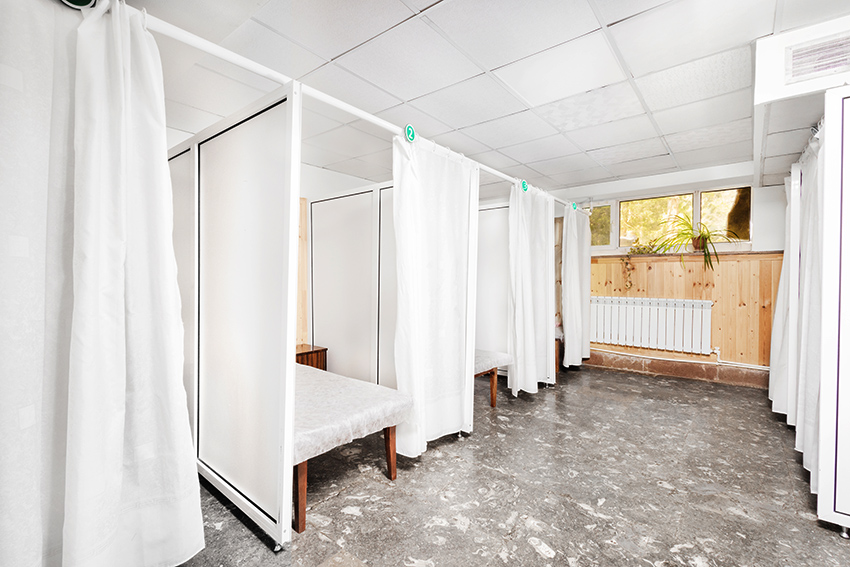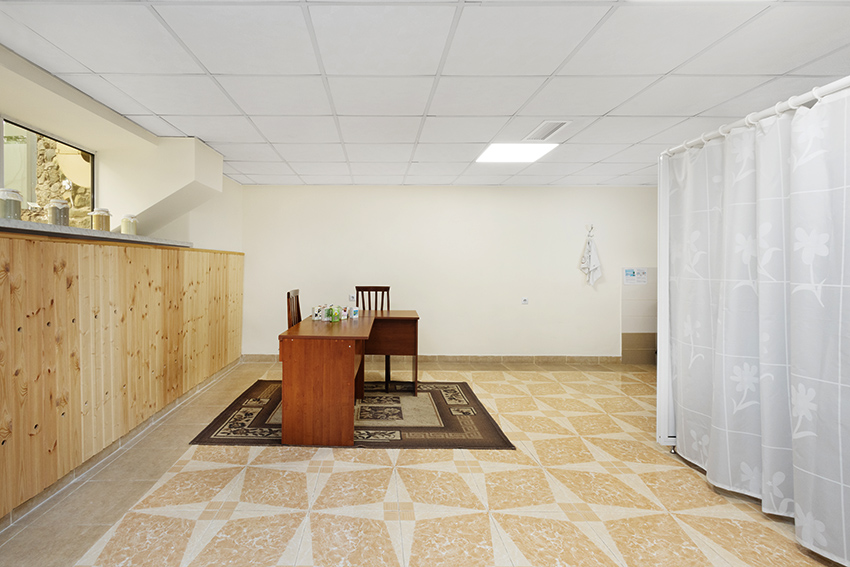Treatment with Paraffin, Peat and Clay
Paraffin Therapy

Paraffin is a wax-like substance consisting of a mixture of solid hydrocarbons of the methane series with mostly normal structure with 18-35 carbon atoms in the molecule; it also contains a number of isoparaffin hydrocarbons, hydrocarbons with aromatic or naphthenic nucleus in the molecule. Due to its high heat capacity and low thermal conductivity and convection, paraffin is widely used in medicine. There are two types of paraffin: yellow (technical) and white (medical).
Paraffin should not be melt or warmed up on fire because it quickly ignites. To apply it is heated on a steam bath. The melting point of the wax is 520-550 C. In order to disinfect, after melting the wax is heated to 1100-1200 C, and then adjusted to the desired temperature. Being used for several times, wax begins to dry and crumble. It needs to be freshened up by adding 20% of new wax.
1-1.5 cm thick paraffin is placed on the painful area of the body, wrapped in oilcloth and wool blanket, and kept for 30-60 minutes. After removing the wax skin is reddened and sweaty. You need to remove the pot and keep the area warm. The procedure with the duration of 15-20 minutes is carried out every day or every other day.
The cuvette-completed application technique is most widespread. The molten paraffin is poured into the cuvettes/cells (5 cm deep), lined with medical oilcloth.
Paraffin baths for hands or feet are normally used, as well as gynecological swabs. Common reactions to paraffin procedures are not strongly expressed: moderate strengthening of the pulse, and sweating, and a little general weakness. Due to its absorbent, anti-inflammatory, analgesic and antispasmodic effects, paraffin is widely used in medical, surgical, gynecological and neurological clinics against numerous diseases.
Paraffin baths stimulate trophic, regenerative processes, reduce muscle spasms, pain, have absorbable and anti-inflammatory effects. When heated, blood flow increases thanks to the expansion of capillaries, flushing of the skin enhances the metabolism of the underlying tissue.
Indications:
• Infectious traumatic arthritis, bursitis, closed fractures, osteomyelitis, infiltrates, hemorrhages, hard scars, adhesions, neuralgia, neuritis, lumbosciatica, chronic female genital infection, chronic hepatitis, gastric ulcer and duodenal ulcer, etc.
Contraindications:
• The above-mentioned diseases in the acute stage
Reference: A. N. Obrosov
Peat Therapy
Peat /german: torf/ - fossil fuel formed by natural withering away and partial decomposition of marsh plants in conditions of high humidity and lack of air. Peat is an organic substance consisting of incompletely decomposed plant residues, their degradation products (humus) and mineral particles. Peat has a complex chemical composition, which is determined by the conditions of its origin, the chemical composition of plant residues and their degree of decomposition.
Combustible peat ingredients:
1. Carbon: 50 - 60%
2. Hydrogen: 5 - 6.5%
3. Oxygen: 30 - 40%
4. Sulfur: 0.1 - 1.5%
Peat is a polydisperse complex multi-component system, which is characterized by high natural moisture content, porosity and high compression ratio.
The peat used in peat therapy usually meets all sanitary requirements. Most effective is the plant peat of high degree of decomposition heated to 42-52 C, which has high organic content, low thermal conductivity, large heat capacity. The commonly used method is the applicator, sometimes in combination with electrotherapy.
Therapeutic effect of peat on the body.
1. Improves blood circulation
2. Stimulates metabolism
3. Accelerates the absorption of pathogenic infiltration
4. Soothes inflammation
5. Reduces swelling, relieves pain.
Indications:
• Musculoskeletal, chronic diseases of joints
• Sciatica, neuritis, plexitis and traumatic injuries
• Gynecological diseases
• Prostatitis, severe scarring, post-operative adhesions.
Contraindications:
• The above-mentioned diseases in the acute stage
• Acute inflammatory diseases.
• Bleeding
• Tuberculosis
• Cardiovascular disease
• Cerebrovascular sclerosis
• Malignant tumors
• Gastric and duodenal ulcers.
In Armenia, “Arzni” resort has a lot of experience in peat therapy starting from the 30s of the last century to the present day, and has a good reputation in Europe and the CIS.
Clay Treatment

Medicinal properties of clay have been known since ancient times. Clay is rich in mineral salts and micronutrients: it contains magnesium, calcium, nitrogen, iron, silica, phosphorus, silicon, etc. Clay absorbs toxic substances, on the other hand it provides all the macro and micro elements that are important for the body. It is known that the clay has strong anti-bacterial, anti-cancer properties. Most of this is attributed to the presence of the radioactive element radium in clay. Clay is a very effective and natural way to cleanse, which regulates metabolism and the human biological field.
Thus, clay radiates heat and leaves a therapeutic effect. External application of clay in various skin diseases (boil, neurodermatitis) fairly quickly leaves a positive effect.
Indications:
• Diseases of the peripheral nervous system
• Arthritis, arthrosis, osteochondrosis
• Pain in the joints, pain in the limbs, fractures
• Skin diseases, atopic dermatitis, boils
Contraindications:
• Acute and chronic diseases in the acute stage
Reference: N. Semenova

